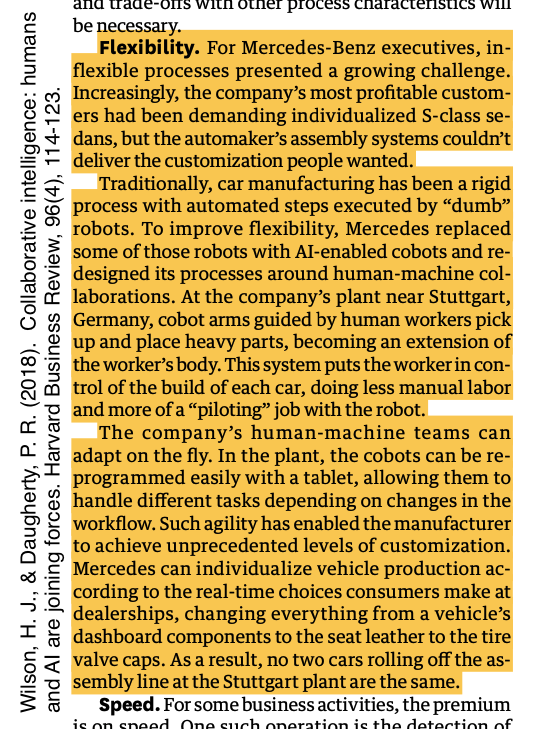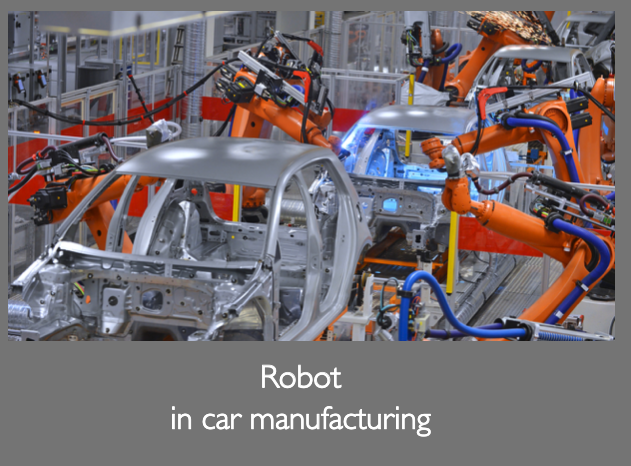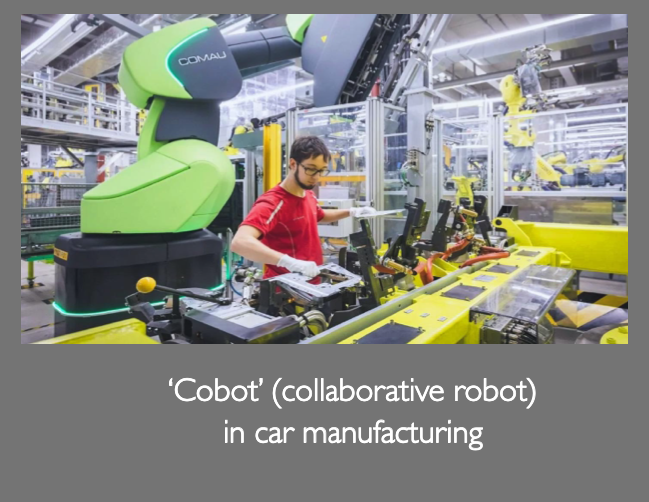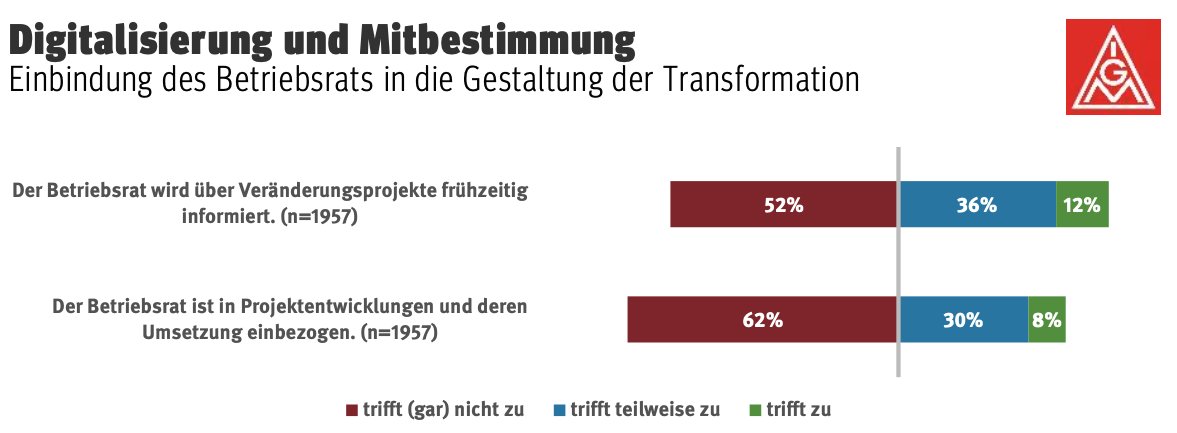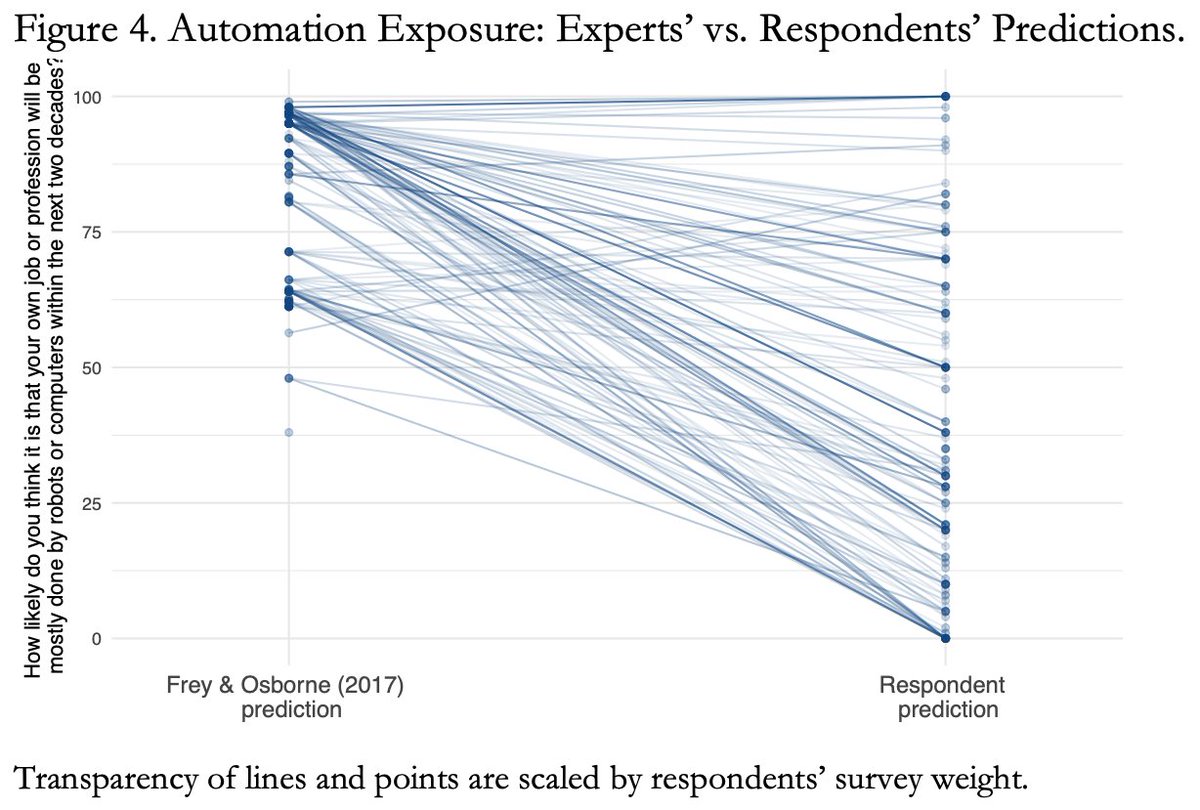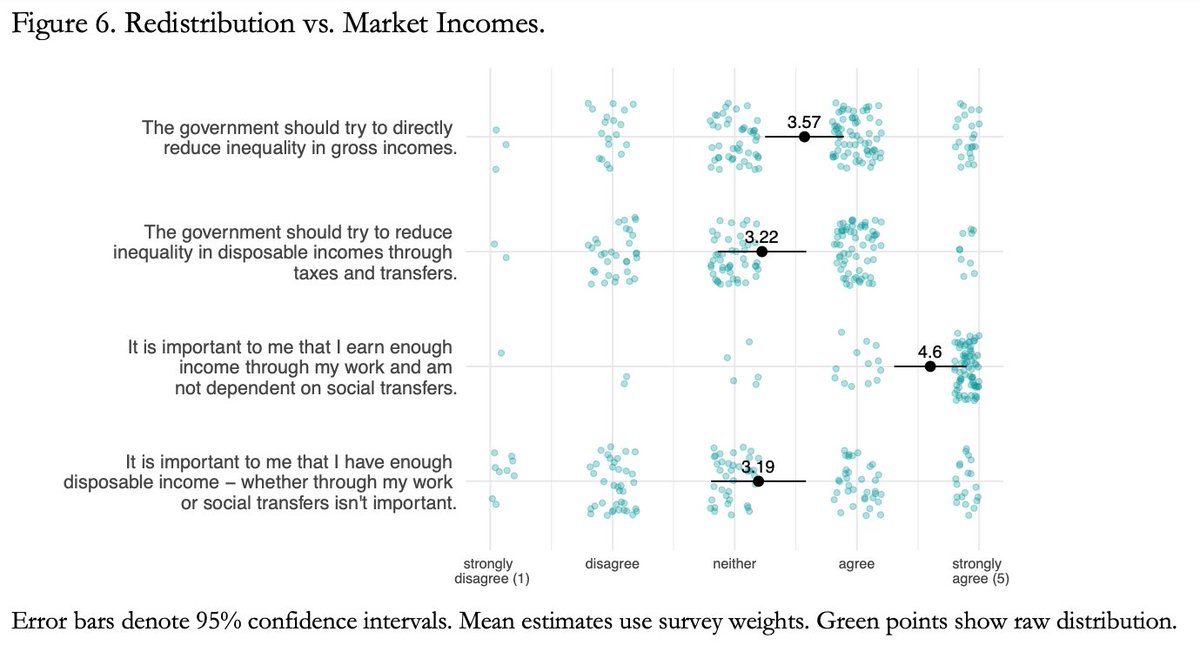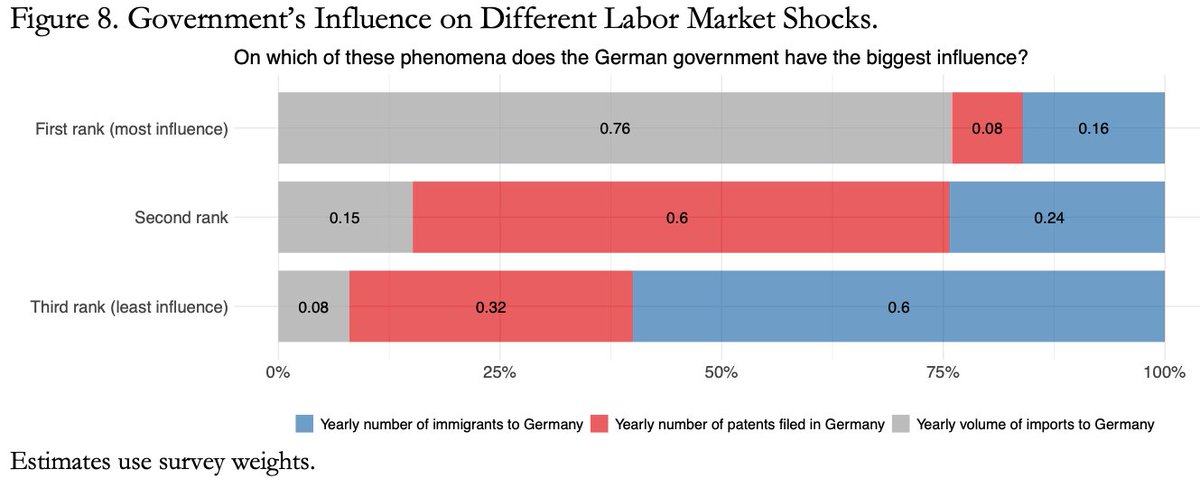Current debates on automation and income inequality miss two points:
1. Redistribution is not enough – we can & should also directly improve market incomes
2. Workers adjusting to new technologies is not enough – we can & should make innovation itself more worker-friendly
 https://abs.twimg.com/emoji/v2/... draggable="false" alt="🧵" title="Thread" aria-label="Emoji: Thread">1/30
https://abs.twimg.com/emoji/v2/... draggable="false" alt="🧵" title="Thread" aria-label="Emoji: Thread">1/30
1. Redistribution is not enough – we can & should also directly improve market incomes
2. Workers adjusting to new technologies is not enough – we can & should make innovation itself more worker-friendly
Thread based on my Second Year Policy Analysis at @Kennedy_School, advised by @rodrikdani in @rema_nadeem’s seminar. Presenting results of a survey experiment with 321 German workers at high risk of automation, funded by @HarvardCID & Malcolm Wiener @InequalityHKS
Let’s dive in
Let’s dive in
Like in other advanced economies, disposable income inequality in Germany increased in recent decades.
Since 90s, richer households experienced larger income growth than poorer households ( https://abs.twimg.com/emoji/v2/... draggable="false" alt="👇" title="Rückhand Zeigefinger nach unten" aria-label="Emoji: Rückhand Zeigefinger nach unten">figure by @DIW_Berlin_en). Gini coefficient rose from 0.23 in 1980s to 0.29 in 2017.
https://abs.twimg.com/emoji/v2/... draggable="false" alt="👇" title="Rückhand Zeigefinger nach unten" aria-label="Emoji: Rückhand Zeigefinger nach unten">figure by @DIW_Berlin_en). Gini coefficient rose from 0.23 in 1980s to 0.29 in 2017.
Since 90s, richer households experienced larger income growth than poorer households (
Increase in disposable income inequality stems from an increase in *market income inequality* – not from less redistribution through taxes and transfers.
Market income share of bottom 50% dropped from one third to <20% ( https://abs.twimg.com/emoji/v2/... draggable="false" alt="👇" title="Rückhand Zeigefinger nach unten" aria-label="Emoji: Rückhand Zeigefinger nach unten"> @CharlyBartels). Gini of market inc in
https://abs.twimg.com/emoji/v2/... draggable="false" alt="👇" title="Rückhand Zeigefinger nach unten" aria-label="Emoji: Rückhand Zeigefinger nach unten"> @CharlyBartels). Gini of market inc in  https://abs.twimg.com/emoji/v2/... draggable="false" alt="🇩🇪" title="Flagge von Deutschland" aria-label="Emoji: Flagge von Deutschland">: 0.5(same as
https://abs.twimg.com/emoji/v2/... draggable="false" alt="🇩🇪" title="Flagge von Deutschland" aria-label="Emoji: Flagge von Deutschland">: 0.5(same as https://abs.twimg.com/emoji/v2/... draggable="false" alt="🇺🇸" title="Flagge der Vereinigten Staaten" aria-label="Emoji: Flagge der Vereinigten Staaten">)
https://abs.twimg.com/emoji/v2/... draggable="false" alt="🇺🇸" title="Flagge der Vereinigten Staaten" aria-label="Emoji: Flagge der Vereinigten Staaten">)
Market income share of bottom 50% dropped from one third to <20% (
Many drivers of unequal market incomes, but a main culprit: technological change.
 https://abs.twimg.com/emoji/v2/... draggable="false" alt="⬇️" title="Pfeil nach unten" aria-label="Emoji: Pfeil nach unten">cost of automation ->
https://abs.twimg.com/emoji/v2/... draggable="false" alt="⬇️" title="Pfeil nach unten" aria-label="Emoji: Pfeil nach unten">cost of automation ->  https://abs.twimg.com/emoji/v2/... draggable="false" alt="⬇️" title="Pfeil nach unten" aria-label="Emoji: Pfeil nach unten">labor demand, and thus
https://abs.twimg.com/emoji/v2/... draggable="false" alt="⬇️" title="Pfeil nach unten" aria-label="Emoji: Pfeil nach unten">labor demand, and thus  https://abs.twimg.com/emoji/v2/... draggable="false" alt="⬇️" title="Pfeil nach unten" aria-label="Emoji: Pfeil nach unten">employment in middle-wage jobs with high shares of routine tasks.
https://abs.twimg.com/emoji/v2/... draggable="false" alt="⬇️" title="Pfeil nach unten" aria-label="Emoji: Pfeil nach unten">employment in middle-wage jobs with high shares of routine tasks.
Also, https://abs.twimg.com/emoji/v2/... draggable="false" alt="⬆️" title="Pfeil nach oben" aria-label="Emoji: Pfeil nach oben">wage premium for high-skilled workers with non-routine, cognitive tasks.
https://abs.twimg.com/emoji/v2/... draggable="false" alt="⬆️" title="Pfeil nach oben" aria-label="Emoji: Pfeil nach oben">wage premium for high-skilled workers with non-routine, cognitive tasks.
Also,
Some direct evidence from @jsuedekum from robot adoption in German manufacturing 1994-2014: https://abs.twimg.com/emoji/v2/... draggable="false" alt="⬆️" title="Pfeil nach oben" aria-label="Emoji: Pfeil nach oben">earnings for managers,
https://abs.twimg.com/emoji/v2/... draggable="false" alt="⬆️" title="Pfeil nach oben" aria-label="Emoji: Pfeil nach oben">earnings for managers,  https://abs.twimg.com/emoji/v2/... draggable="false" alt="⬇️" title="Pfeil nach unten" aria-label="Emoji: Pfeil nach unten">earnings for machine operators. And employment adjusts mostly through new entries & exits to labor force (which is slower & more unequal: https://bit.ly/2PRSawq )">https://bit.ly/2PRSawq&q...
https://abs.twimg.com/emoji/v2/... draggable="false" alt="⬇️" title="Pfeil nach unten" aria-label="Emoji: Pfeil nach unten">earnings for machine operators. And employment adjusts mostly through new entries & exits to labor force (which is slower & more unequal: https://bit.ly/2PRSawq )">https://bit.ly/2PRSawq&q...
Advances in AI and robotics extend the scope of routine tasks that can be profitably automated. @LjubicaNed & @Glenda_Quintini estimate 1/5 of jobs in https://abs.twimg.com/emoji/v2/... draggable="false" alt="🇩🇪" title="Flagge von Deutschland" aria-label="Emoji: Flagge von Deutschland">are at high risk of automation. And the pandemic increased incentives to substitute labor with capital https://econ.st/3a0xVU8 ">https://econ.st/3a0xVU8&q...
https://abs.twimg.com/emoji/v2/... draggable="false" alt="🇩🇪" title="Flagge von Deutschland" aria-label="Emoji: Flagge von Deutschland">are at high risk of automation. And the pandemic increased incentives to substitute labor with capital https://econ.st/3a0xVU8 ">https://econ.st/3a0xVU8&q...
How should policymakers respond? Current proposals focus on redistribution. More generous unemployment schemes, support for retraining, UIB all aim to reduce income inequality through transfers rather than directly curb it where it emerges: in the market (matrix by @rodrikdani)
The focus on redistribution seems to stem from an overly deterministic view of technological change: an exogenous shock on which policy has little influence and to which workers need to adjust (or be compensated for) rather than something that can be adjusted to benefit workers.
BUT innovation can be steered into a more worker-friendly direction. Research by @DrDaronAcemoglu @MazzucatoM &others show that tech development & adoption respond to economic incentives and social norms set by innovation and industrial policies. Govts *already* shape tech change
AND this does not have to come at the cost of productivity. Firms can often choose between technologies with similar productivity effects but varying effects on the composition of labor demand.
Example: Mercedes Benz replaced some robots with ‘cobots’ – instead of replacing workers in the assembly line, collaborative robots extend workers’ capabilities to perform tasks. This allowed Mercedes Benz greater customization of cars demanded by its most profitable customers
Ok, but what *exactly* should we do?
Four policy ideas for more inclusive technological change:
Four policy ideas for more inclusive technological change:
1 *Firm-level participatory processes on innovation* could help managers identify labor-augmenting technologies that are more productive than labor-substituting alternatives. Work councils’ current consultation rights are inadequate; half are not consulted on innovation questions
WCA could be reformed to include *procedural* codetermination for work councils. Also @BMAS_Bund Experimentierräume program could be scaled: subsidized scheme in which managers and workers can jointly explore, develop, and test different technology options https://www.experimentierraeume.de/ ">https://www.experimentierraeume.de/">...
2. “So-so” technologies (Acemoglu & @pascualrpo ) are particularly harmful: sufficiently productive to be adopted & displace labor but not so productive to reinstate labor through growing economy. As AI expands to areas where humans are relatively good, we& #39;ll see more of these.
*Higher capital taxes* could disincentivize the adoption of these “so-so” technologies. Reason to believe that the tax code in https://abs.twimg.com/emoji/v2/... draggable="false" alt="🇩🇪" title="Flagge von Deutschland" aria-label="Emoji: Flagge von Deutschland">, like in
https://abs.twimg.com/emoji/v2/... draggable="false" alt="🇩🇪" title="Flagge von Deutschland" aria-label="Emoji: Flagge von Deutschland">, like in https://abs.twimg.com/emoji/v2/... draggable="false" alt="🇺🇸" title="Flagge der Vereinigten Staaten" aria-label="Emoji: Flagge der Vereinigten Staaten">, is biased towards capital. Advances on global minimal tax will allow for the reallocation some of the tax burden from labor to capital.
https://abs.twimg.com/emoji/v2/... draggable="false" alt="🇺🇸" title="Flagge der Vereinigten Staaten" aria-label="Emoji: Flagge der Vereinigten Staaten">, is biased towards capital. Advances on global minimal tax will allow for the reallocation some of the tax burden from labor to capital.
3. *Directed research funding* could promote employment-friendly technologies. In the same way the govt prioritizes green technologies for positive climate externalities, it could prioritize labor-augmenting technologies for “good jobs” externalities. https://www.project-syndicate.org/commentary/new-social-contract-must-target-good-job-creation-by-dani-rodrik-and-stefanie-stantcheva-2020-06">https://www.project-syndicate.org/commentar...
4. *Higher stock ownership by low&middle-income workers* could generate capital market income for those whose incomes fall due to automation. If infeasible for individuals, govt could set up sovereign wealth fund, paying dividends to citizens. Ex from https://abs.twimg.com/emoji/v2/... draggable="false" alt="🇺🇸" title="Flagge der Vereinigten Staaten" aria-label="Emoji: Flagge der Vereinigten Staaten">: Alaska Permanent Fund
https://abs.twimg.com/emoji/v2/... draggable="false" alt="🇺🇸" title="Flagge der Vereinigten Staaten" aria-label="Emoji: Flagge der Vereinigten Staaten">: Alaska Permanent Fund
Without natural resources, govt could finance purchase of assets through capital, IPO, or M&A taxes. @MattBruenig developed idea for https://abs.twimg.com/emoji/v2/... draggable="false" alt="🇺🇸" title="Flagge der Vereinigten Staaten" aria-label="Emoji: Flagge der Vereinigten Staaten">: https://www.peoplespolicyproject.org/projects/social-wealth-fund/).">https://www.peoplespolicyproject.org/projects/... But to pay every adult 800€ & every child 400€ in
https://abs.twimg.com/emoji/v2/... draggable="false" alt="🇺🇸" title="Flagge der Vereinigten Staaten" aria-label="Emoji: Flagge der Vereinigten Staaten">: https://www.peoplespolicyproject.org/projects/social-wealth-fund/).">https://www.peoplespolicyproject.org/projects/... But to pay every adult 800€ & every child 400€ in https://abs.twimg.com/emoji/v2/... draggable="false" alt="🇩🇪" title="Flagge von Deutschland" aria-label="Emoji: Flagge von Deutschland">per year, fund would have to grow to 59% of GDP in 2018
https://abs.twimg.com/emoji/v2/... draggable="false" alt="🇩🇪" title="Flagge von Deutschland" aria-label="Emoji: Flagge von Deutschland">per year, fund would have to grow to 59% of GDP in 2018
What do affected workers think about all this? To find out, I conducted a randomized survey experiment with 321 workers, representative of 30 occupations at high risk of automation. Sampling done through targeted Facebook ads (similar approach as @dannyjschneider& #39;s Shift Project)
A random half of the workers were shown their occupation-specific automation risk & text that emphasized human agency over the direction of technological change. Automation risks estimates were taken from existing literature & measure technological feasibility of automation
1. Relative to expert predictions, workers underestimate their occupations’ risk of automation within the next 2 decades by 44 percentage pts. Treatment did not lead to meaningful changes in the perceptions of personal automation risk. Information failure may call for govt action
2. When asked directly, workers strongly prefer increasing market incomes to increasing redistribution. Many state that it is very important to them to earn their incomes self-sufficiently rather than through transfers.
3. Workers ascribe the German government some influence on technological change. For example, they believe it has a higher influence on the number of new patents filed in Germany than the number of new immigrants arriving in Germany.
4. There is latent demand for giving work councils a larger role in firm-level technology adoption. With the treatment, strengthening work councils’ rights is the most popular policy proposal among the eight proposals included in the study. In control, wealth tax is very popular.
So, what did I learn? If you want to make the technological transformation work for those currently left behind, you should not focus on redistribution and compensation alone.
We can influence the type and direction of technological change …
We can influence the type and direction of technological change …
… and a narrative that recognizes this can leverage a much broader policy toolkit: increased capital taxation, directed research funding, higher stock ownership rates, and stronger involvement of workers in firm-level technology decisions.
These policies have the potential to directly improve workers’ market incomes. And to the extent that they appeal to workers’ sense of autonomy instead of painting a picture of “economic losers” that deserve compensation, they likely have more political support.
I hope to publish a more academic write up of the survey results soon – in the meantime, do reach out with questions and comments https://abs.twimg.com/emoji/v2/... draggable="false" alt="😊" title="Lächelndes Gesicht mit lächelnden Augen" aria-label="Emoji: Lächelndes Gesicht mit lächelnden Augen">
https://abs.twimg.com/emoji/v2/... draggable="false" alt="😊" title="Lächelndes Gesicht mit lächelnden Augen" aria-label="Emoji: Lächelndes Gesicht mit lächelnden Augen">

 Read on Twitter
Read on Twitter
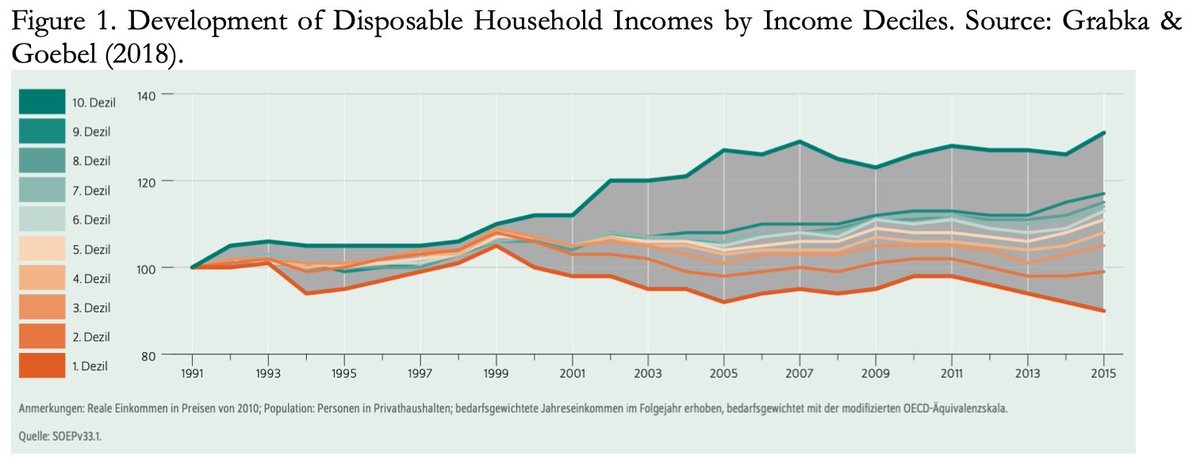 figure by @DIW_Berlin_en). Gini coefficient rose from 0.23 in 1980s to 0.29 in 2017." title="Like in other advanced economies, disposable income inequality in Germany increased in recent decades. Since 90s, richer households experienced larger income growth than poorer households (https://abs.twimg.com/emoji/v2/... draggable="false" alt="👇" title="Rückhand Zeigefinger nach unten" aria-label="Emoji: Rückhand Zeigefinger nach unten">figure by @DIW_Berlin_en). Gini coefficient rose from 0.23 in 1980s to 0.29 in 2017." class="img-responsive" style="max-width:100%;"/>
figure by @DIW_Berlin_en). Gini coefficient rose from 0.23 in 1980s to 0.29 in 2017." title="Like in other advanced economies, disposable income inequality in Germany increased in recent decades. Since 90s, richer households experienced larger income growth than poorer households (https://abs.twimg.com/emoji/v2/... draggable="false" alt="👇" title="Rückhand Zeigefinger nach unten" aria-label="Emoji: Rückhand Zeigefinger nach unten">figure by @DIW_Berlin_en). Gini coefficient rose from 0.23 in 1980s to 0.29 in 2017." class="img-responsive" style="max-width:100%;"/>
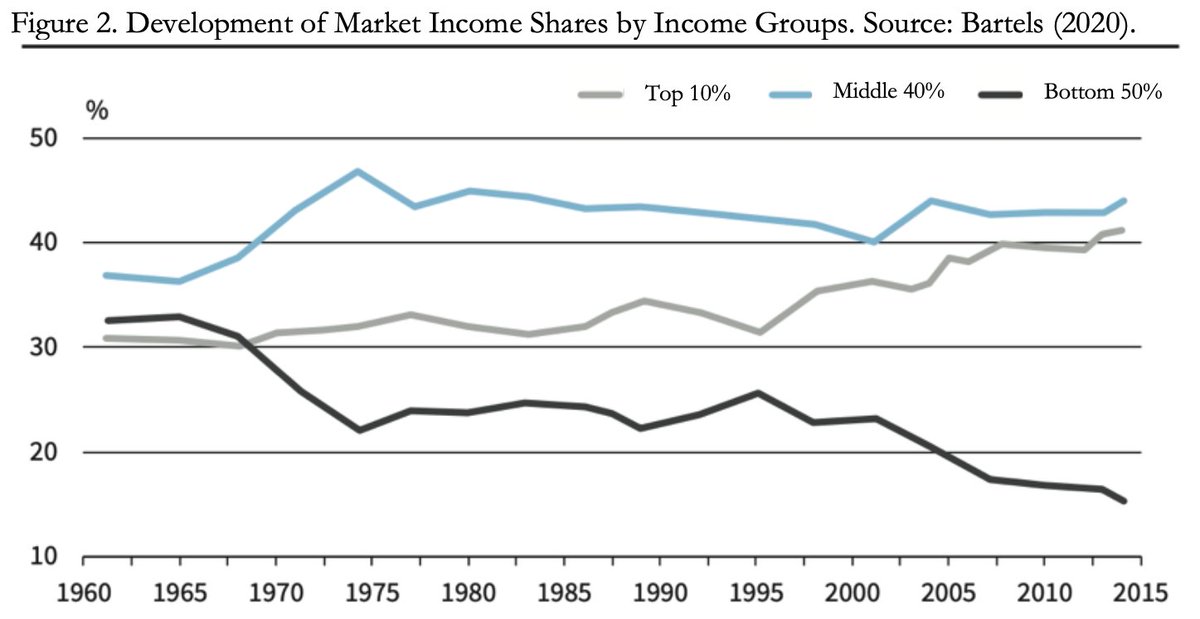 @CharlyBartels). Gini of market inc in https://abs.twimg.com/emoji/v2/... draggable="false" alt="🇩🇪" title="Flagge von Deutschland" aria-label="Emoji: Flagge von Deutschland">: 0.5(same ashttps://abs.twimg.com/emoji/v2/... draggable="false" alt="🇺🇸" title="Flagge der Vereinigten Staaten" aria-label="Emoji: Flagge der Vereinigten Staaten">)" title="Increase in disposable income inequality stems from an increase in *market income inequality* – not from less redistribution through taxes and transfers.Market income share of bottom 50% dropped from one third to <20% (https://abs.twimg.com/emoji/v2/... draggable="false" alt="👇" title="Rückhand Zeigefinger nach unten" aria-label="Emoji: Rückhand Zeigefinger nach unten"> @CharlyBartels). Gini of market inc in https://abs.twimg.com/emoji/v2/... draggable="false" alt="🇩🇪" title="Flagge von Deutschland" aria-label="Emoji: Flagge von Deutschland">: 0.5(same ashttps://abs.twimg.com/emoji/v2/... draggable="false" alt="🇺🇸" title="Flagge der Vereinigten Staaten" aria-label="Emoji: Flagge der Vereinigten Staaten">)" class="img-responsive" style="max-width:100%;"/>
@CharlyBartels). Gini of market inc in https://abs.twimg.com/emoji/v2/... draggable="false" alt="🇩🇪" title="Flagge von Deutschland" aria-label="Emoji: Flagge von Deutschland">: 0.5(same ashttps://abs.twimg.com/emoji/v2/... draggable="false" alt="🇺🇸" title="Flagge der Vereinigten Staaten" aria-label="Emoji: Flagge der Vereinigten Staaten">)" title="Increase in disposable income inequality stems from an increase in *market income inequality* – not from less redistribution through taxes and transfers.Market income share of bottom 50% dropped from one third to <20% (https://abs.twimg.com/emoji/v2/... draggable="false" alt="👇" title="Rückhand Zeigefinger nach unten" aria-label="Emoji: Rückhand Zeigefinger nach unten"> @CharlyBartels). Gini of market inc in https://abs.twimg.com/emoji/v2/... draggable="false" alt="🇩🇪" title="Flagge von Deutschland" aria-label="Emoji: Flagge von Deutschland">: 0.5(same ashttps://abs.twimg.com/emoji/v2/... draggable="false" alt="🇺🇸" title="Flagge der Vereinigten Staaten" aria-label="Emoji: Flagge der Vereinigten Staaten">)" class="img-responsive" style="max-width:100%;"/>
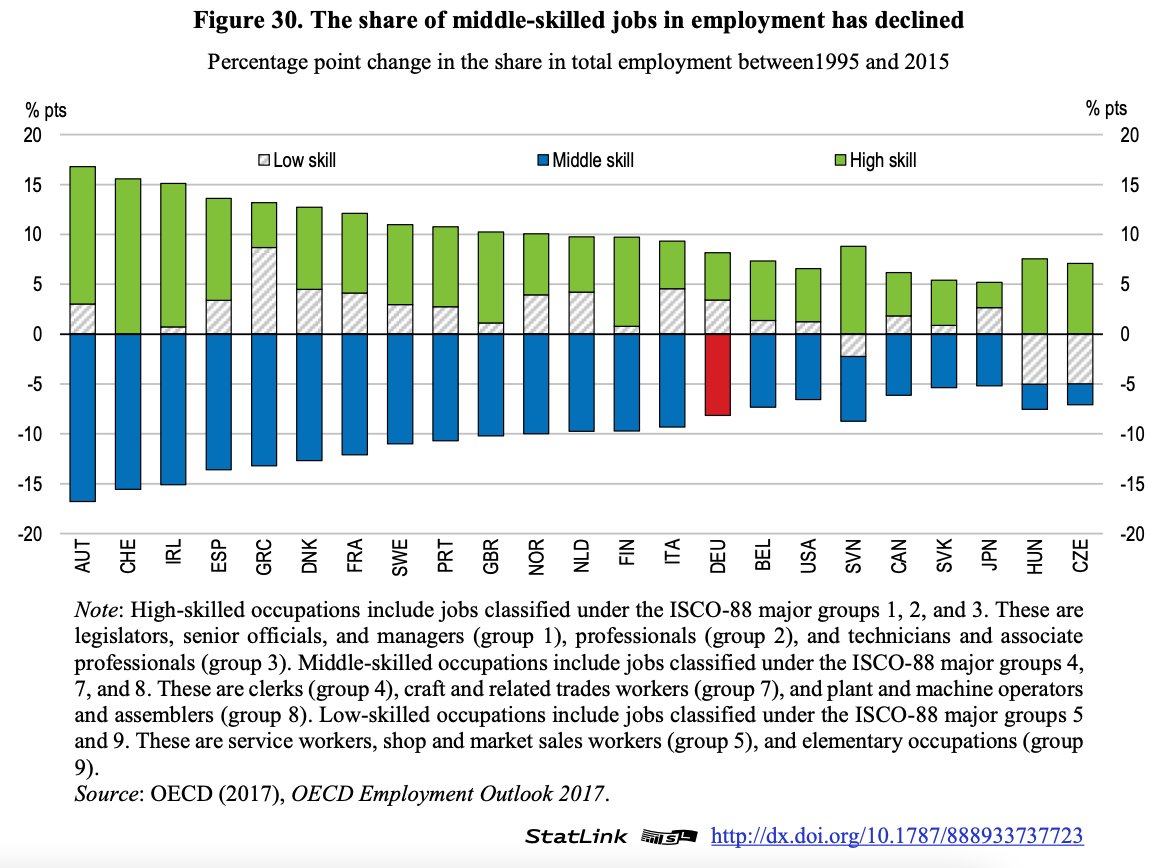 cost of automation -> https://abs.twimg.com/emoji/v2/... draggable="false" alt="⬇️" title="Pfeil nach unten" aria-label="Emoji: Pfeil nach unten">labor demand, and thus https://abs.twimg.com/emoji/v2/... draggable="false" alt="⬇️" title="Pfeil nach unten" aria-label="Emoji: Pfeil nach unten">employment in middle-wage jobs with high shares of routine tasks.Also,https://abs.twimg.com/emoji/v2/... draggable="false" alt="⬆️" title="Pfeil nach oben" aria-label="Emoji: Pfeil nach oben">wage premium for high-skilled workers with non-routine, cognitive tasks." title="Many drivers of unequal market incomes, but a main culprit: technological change. https://abs.twimg.com/emoji/v2/... draggable="false" alt="⬇️" title="Pfeil nach unten" aria-label="Emoji: Pfeil nach unten">cost of automation -> https://abs.twimg.com/emoji/v2/... draggable="false" alt="⬇️" title="Pfeil nach unten" aria-label="Emoji: Pfeil nach unten">labor demand, and thus https://abs.twimg.com/emoji/v2/... draggable="false" alt="⬇️" title="Pfeil nach unten" aria-label="Emoji: Pfeil nach unten">employment in middle-wage jobs with high shares of routine tasks.Also,https://abs.twimg.com/emoji/v2/... draggable="false" alt="⬆️" title="Pfeil nach oben" aria-label="Emoji: Pfeil nach oben">wage premium for high-skilled workers with non-routine, cognitive tasks.">
cost of automation -> https://abs.twimg.com/emoji/v2/... draggable="false" alt="⬇️" title="Pfeil nach unten" aria-label="Emoji: Pfeil nach unten">labor demand, and thus https://abs.twimg.com/emoji/v2/... draggable="false" alt="⬇️" title="Pfeil nach unten" aria-label="Emoji: Pfeil nach unten">employment in middle-wage jobs with high shares of routine tasks.Also,https://abs.twimg.com/emoji/v2/... draggable="false" alt="⬆️" title="Pfeil nach oben" aria-label="Emoji: Pfeil nach oben">wage premium for high-skilled workers with non-routine, cognitive tasks." title="Many drivers of unequal market incomes, but a main culprit: technological change. https://abs.twimg.com/emoji/v2/... draggable="false" alt="⬇️" title="Pfeil nach unten" aria-label="Emoji: Pfeil nach unten">cost of automation -> https://abs.twimg.com/emoji/v2/... draggable="false" alt="⬇️" title="Pfeil nach unten" aria-label="Emoji: Pfeil nach unten">labor demand, and thus https://abs.twimg.com/emoji/v2/... draggable="false" alt="⬇️" title="Pfeil nach unten" aria-label="Emoji: Pfeil nach unten">employment in middle-wage jobs with high shares of routine tasks.Also,https://abs.twimg.com/emoji/v2/... draggable="false" alt="⬆️" title="Pfeil nach oben" aria-label="Emoji: Pfeil nach oben">wage premium for high-skilled workers with non-routine, cognitive tasks.">
 cost of automation -> https://abs.twimg.com/emoji/v2/... draggable="false" alt="⬇️" title="Pfeil nach unten" aria-label="Emoji: Pfeil nach unten">labor demand, and thus https://abs.twimg.com/emoji/v2/... draggable="false" alt="⬇️" title="Pfeil nach unten" aria-label="Emoji: Pfeil nach unten">employment in middle-wage jobs with high shares of routine tasks.Also,https://abs.twimg.com/emoji/v2/... draggable="false" alt="⬆️" title="Pfeil nach oben" aria-label="Emoji: Pfeil nach oben">wage premium for high-skilled workers with non-routine, cognitive tasks." title="Many drivers of unequal market incomes, but a main culprit: technological change. https://abs.twimg.com/emoji/v2/... draggable="false" alt="⬇️" title="Pfeil nach unten" aria-label="Emoji: Pfeil nach unten">cost of automation -> https://abs.twimg.com/emoji/v2/... draggable="false" alt="⬇️" title="Pfeil nach unten" aria-label="Emoji: Pfeil nach unten">labor demand, and thus https://abs.twimg.com/emoji/v2/... draggable="false" alt="⬇️" title="Pfeil nach unten" aria-label="Emoji: Pfeil nach unten">employment in middle-wage jobs with high shares of routine tasks.Also,https://abs.twimg.com/emoji/v2/... draggable="false" alt="⬆️" title="Pfeil nach oben" aria-label="Emoji: Pfeil nach oben">wage premium for high-skilled workers with non-routine, cognitive tasks.">
cost of automation -> https://abs.twimg.com/emoji/v2/... draggable="false" alt="⬇️" title="Pfeil nach unten" aria-label="Emoji: Pfeil nach unten">labor demand, and thus https://abs.twimg.com/emoji/v2/... draggable="false" alt="⬇️" title="Pfeil nach unten" aria-label="Emoji: Pfeil nach unten">employment in middle-wage jobs with high shares of routine tasks.Also,https://abs.twimg.com/emoji/v2/... draggable="false" alt="⬆️" title="Pfeil nach oben" aria-label="Emoji: Pfeil nach oben">wage premium for high-skilled workers with non-routine, cognitive tasks." title="Many drivers of unequal market incomes, but a main culprit: technological change. https://abs.twimg.com/emoji/v2/... draggable="false" alt="⬇️" title="Pfeil nach unten" aria-label="Emoji: Pfeil nach unten">cost of automation -> https://abs.twimg.com/emoji/v2/... draggable="false" alt="⬇️" title="Pfeil nach unten" aria-label="Emoji: Pfeil nach unten">labor demand, and thus https://abs.twimg.com/emoji/v2/... draggable="false" alt="⬇️" title="Pfeil nach unten" aria-label="Emoji: Pfeil nach unten">employment in middle-wage jobs with high shares of routine tasks.Also,https://abs.twimg.com/emoji/v2/... draggable="false" alt="⬆️" title="Pfeil nach oben" aria-label="Emoji: Pfeil nach oben">wage premium for high-skilled workers with non-routine, cognitive tasks.">
 earnings for managers, https://abs.twimg.com/emoji/v2/... draggable="false" alt="⬇️" title="Pfeil nach unten" aria-label="Emoji: Pfeil nach unten">earnings for machine operators. And employment adjusts mostly through new entries & exits to labor force (which is slower & more unequal: https://bit.ly/2PRSawq&q..." title="Some direct evidence from @jsuedekum from robot adoption in German manufacturing 1994-2014:https://abs.twimg.com/emoji/v2/... draggable="false" alt="⬆️" title="Pfeil nach oben" aria-label="Emoji: Pfeil nach oben">earnings for managers, https://abs.twimg.com/emoji/v2/... draggable="false" alt="⬇️" title="Pfeil nach unten" aria-label="Emoji: Pfeil nach unten">earnings for machine operators. And employment adjusts mostly through new entries & exits to labor force (which is slower & more unequal: https://bit.ly/2PRSawq&q..." class="img-responsive" style="max-width:100%;"/>
earnings for managers, https://abs.twimg.com/emoji/v2/... draggable="false" alt="⬇️" title="Pfeil nach unten" aria-label="Emoji: Pfeil nach unten">earnings for machine operators. And employment adjusts mostly through new entries & exits to labor force (which is slower & more unequal: https://bit.ly/2PRSawq&q..." title="Some direct evidence from @jsuedekum from robot adoption in German manufacturing 1994-2014:https://abs.twimg.com/emoji/v2/... draggable="false" alt="⬆️" title="Pfeil nach oben" aria-label="Emoji: Pfeil nach oben">earnings for managers, https://abs.twimg.com/emoji/v2/... draggable="false" alt="⬇️" title="Pfeil nach unten" aria-label="Emoji: Pfeil nach unten">earnings for machine operators. And employment adjusts mostly through new entries & exits to labor force (which is slower & more unequal: https://bit.ly/2PRSawq&q..." class="img-responsive" style="max-width:100%;"/>
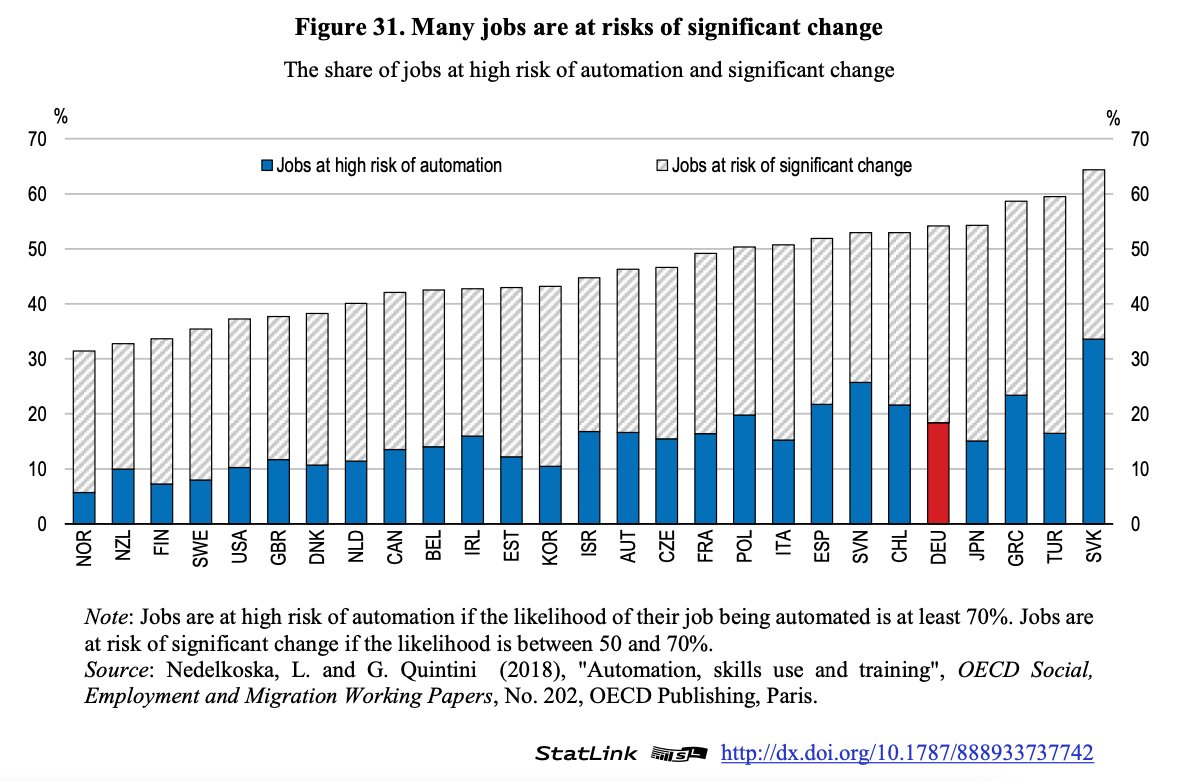 are at high risk of automation. And the pandemic increased incentives to substitute labor with capital https://econ.st/3a0xVU8&q..." title="Advances in AI and robotics extend the scope of routine tasks that can be profitably automated. @LjubicaNed & @Glenda_Quintini estimate 1/5 of jobs inhttps://abs.twimg.com/emoji/v2/... draggable="false" alt="🇩🇪" title="Flagge von Deutschland" aria-label="Emoji: Flagge von Deutschland">are at high risk of automation. And the pandemic increased incentives to substitute labor with capital https://econ.st/3a0xVU8&q..." class="img-responsive" style="max-width:100%;"/>
are at high risk of automation. And the pandemic increased incentives to substitute labor with capital https://econ.st/3a0xVU8&q..." title="Advances in AI and robotics extend the scope of routine tasks that can be profitably automated. @LjubicaNed & @Glenda_Quintini estimate 1/5 of jobs inhttps://abs.twimg.com/emoji/v2/... draggable="false" alt="🇩🇪" title="Flagge von Deutschland" aria-label="Emoji: Flagge von Deutschland">are at high risk of automation. And the pandemic increased incentives to substitute labor with capital https://econ.st/3a0xVU8&q..." class="img-responsive" style="max-width:100%;"/>


